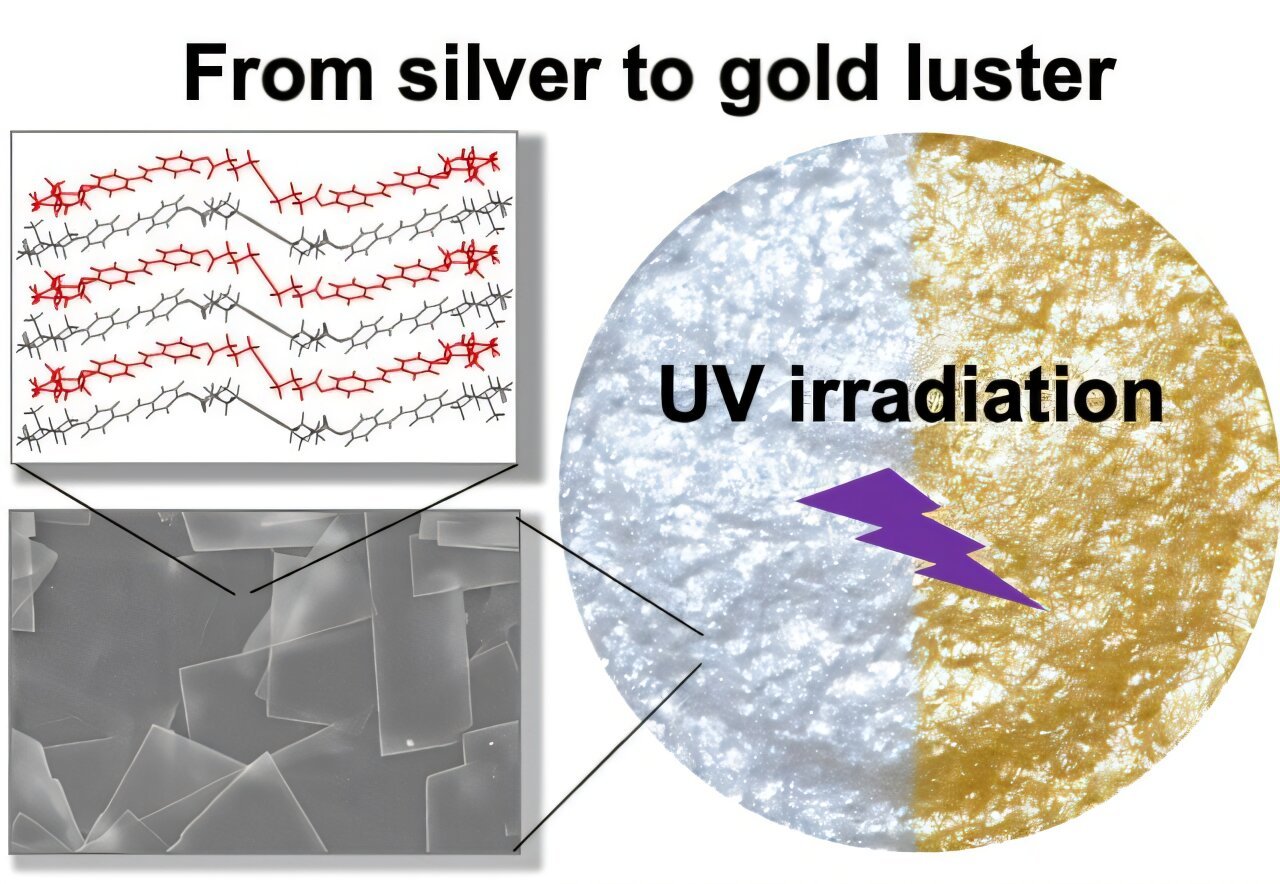
There have been many attempts to create monochromatic metallic materials, but few materials change luster color in response to external stimuli. In a recent breakthrough, researchers from Chiba University have prepared a diacetylene derivative-based metallic luster material that changes from silver to gold under UV irradiation.
These findings are expected to find applications in decorative items, printing inks, photomask patterning, UV laser lithography, and cosmetics.
Societies of the past and present have given high regard to precious metals like gold and silver. Both metals remind us of nobility and luxury. However, they are quite expensive, which restricts their applications. Therefore, materials with attractive but artificial gold- and silver-like metallic lusters are popular, finding use in jewelry, reflective materials, inks, and cosmetics.
Unfortunately, typical metallic luster materials cause environmental harm, rendering them unsustainable. Thus, scientists are actively searching for metal-free alternatives, examining organics such as thiophene, pyrrole, porphyrin, azobenzene, and stilbene derivatives. They have found some success in creating materials whose colors can be tuned by external stimuli while maintaining the metallic luster. However, the task still remains challenging.
Recently, a group of researchers from Chiba University, led by Professor Michinari Kohri and Kyoka Tachibana from the Graduate School of Engineering, in collaboration with scientists from Mitsubishi Pencil Co., Ltd., Tokyo University of Science, Keio University, and Yamagata University, has demonstrated the preparation of a metallic luster material that changes color from silver to gold under UV irradiation.
Their findings were published in ACS Applied Materials & Interfaces on September 14, 2024.
Highlighting the motivation behind this study, Prof. Kohri says, “Expanding on our earlier findings on biomimetic metallic luster materials, we conducted a targeted search for molecular structures capable of transitioning between silver and gold. This effort resulted in the identification of a novel material with desirable properties.”
In this study, researchers developed diacetylene (DA) derivative-based luster materials incorporating stilbenes via linkers at both ends, denoted as DS-DAn (where n represents the linker carbon number, ranging from 1 to 6). Varying n yielded diverse metallic luster and color change behaviors.
After several innovative experimental trials, the researchers observed that the stacked structure of platelet crystals comprising DS-DA1, the derivative with the shortest linker carbon chain, had a silver look. Its luster notably turned to gold upon UV irradiation, a remarkable external stimulus-based behavior.
The team attributed this to the unique crystal structure of DS-DA1 with two coexisting assembled states, revealing that partial topochemical polymerization (a polymerization method performed by monomers that are aligned in the crystal state) of DA within the structure modified its color tone from silver to gold.
The silver luster material developed in this study can express a golden luster selectively in specific areas using only light irradiation. It is also possible to add gradation colors of gold and silver. Thus, it has the potential to be useful in a variety of applications, such as decorative items, printing inks, and cosmetics.
“By eliminating metal components, our innovative material minimizes environmental footprint and weight. Moreover, its suitability for UV laser-based drawing techniques opens up new possibilities for high-end decorative printing. Further exploration of molecular structures may make it possible to express a wider variety of glossy colors,” concludes Prof. Kohri.
This work advances the fundamental science of DA polymerization and unlocks new opportunities for metallic luster materials with desirable properties in photomask patterning and UV laser lithography.
More information:
Kyoka Tachibana et al, Silver to Gold Metallic Luster Changes in Stimuli-Responsive Diacetylene Derivatives Uniquely Arranged within Crystals, ACS Applied Materials & Interfaces (2024). DOI: 10.1021/acsami.4c14218
Citation:
Metallic luster material can change color from silver to gold under UV light (2024, October 30)
retrieved 30 October 2024
from https://phys.org/news/2024-10-metallic-luster-material-silver-gold.html
This document is subject to copyright. Apart from any fair dealing for the purpose of private study or research, no
part may be reproduced without the written permission. The content is provided for information purposes only.






